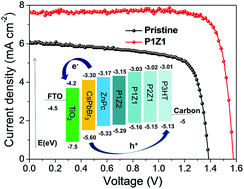Poly(3-hexylthiophene)/zinc phthalocyanine composites for advanced interface engineering of 10.03%-efficiency CsPbBr3 perovskite solar cells†
Abstract
Carbon-based inorganic cesium lead bromide (CsPbBr3) perovskite solar cells have attracted considerable interest because of their excellent environmental stability, simple preparation in air, and good cost effectiveness. However, the poor hole extraction and serious charge recombination at the CsPbBr3/carbon interface caused by a large energy level difference and the inefficient hole selectivity of the carbon cathode as well as surface defect states have remarkably limited the further improvement of the power conversion efficiency of such solar cells. Here, a poly(3-hexylthiophene)/zinc phthalocyanine (P3HT/ZnPc) composite with a tunable energy level was employed as a hole-transport material (HTM) in carbon-based CsPbBr3 perovskite solar cells to reduce the energy level difference and to passivate the surface defect states of perovskites, promoting charge separation and reducing charge recombination at the CsPbBr3/carbon interface. The photovoltaic performance of a solar cell with an architecture of FTO/c-TiO2/m-TiO2/CsPbBr3/P1Z1/carbon was significantly improved, achieving a champion power conversion efficiency as high as 10.03% with a short-circuit current density of 7.652 mA cm−2, an open-circuit voltage of 1.578 V, and a fill factor of 83.06% under one sun illumination. Moreover, the unencapsulated device exhibited excellent long-term stability in air with 70% relative humidity over 30 days. These results suggested that the P3HT/ZnPc composite is an efficient HTM for high-efficiency and stable carbon-based CsPbBr3 perovskite solar cells.



 Please wait while we load your content...
Please wait while we load your content...